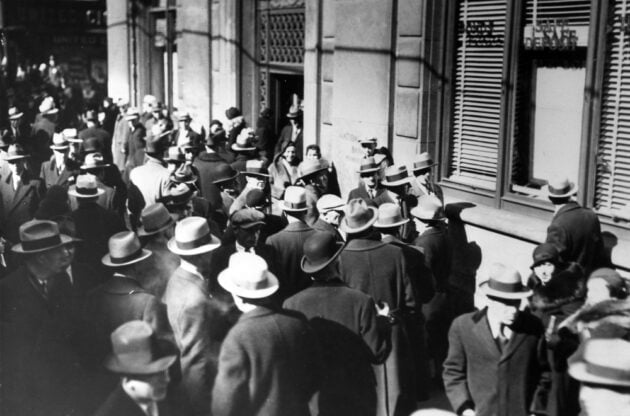When over 9,000 banks failed during the Great Depression, panicked depositors descended on the banks and waited in line for hours… hoping for a chance to demand their money.
This fearful image is burned into our collective memories. And we still expect to see depositors lining up outside of banks when a bank run is in progress.
But today, thanks to cell phones and online banking apps, depositors can move their money to safety in moments with a few quiet clicks. And you and I won’t see or hear it.
If enough of them move their money at the same time, you can call it a silent bank run.
And that’s what happened when Silicon Valley Bank collapsed on Friday, March 10:
A flood of depositors quietly withdrew $42 Billion from the bank in 24 hours without lines forming outside the bank — causing the second-largest collapse in US history. And the blinding speed of the bank’s unraveling caught almost everyone by surprise.
Even Fed Chief Jerome Powell was shocked by the bank’s rapid failure. “The speed of the run [is] very different from what we’ve seen in the past,” he told reporters.
True, Mr. Powell.
But here’s the twist nobody is talking about:
In the aftermath of the SVB bank crash, frightened depositors are pulling their money out of the US banking sector — with little to no media coverage.
But unlike SVB’s lightning-fast bank run during the last 48 hours of its existence… the long, slow, silent bank run in the banking sector started before the collapse — and continues now, fueled by more than fears of bank insolvency.
It’s also about interest rates.
As you may recall, the Fed held interest rates ultra-low for years. This meant holding money in the bank yielded as much as safer but low-yielding Treasury bonds. So, many people kept their deposits in the banks.
However, as the Fed increased interest rates over the last nine months, depositors and investors began moving money out of banks into now higher-yield investments like Treasury bonds. And the higher the rates rose, the more people moved their money out.
And then the trouble started
SVB’s clients included a unique mix of start-up companies struggling to raise venture capital funds due to the higher interest rates. So, customers were moving money out of the bank. Some to seek higher yields and others to fund business needs.
And SVB was using its depositors’ money to invest in US treasuries. They bought them when rates were low, but they began to lose value as rates started to rise. So as more and more clients withdrew their money, the bank was forced to liquidate its flagging investments.
The odd thing is…
The Fed was aware of the banking sector’s waning deposits moving to higher-yield investments.
And they knew about SVB’s risky practices well before the collapse too.
In fact, according to the NY Times, “Silicon Valley Bank’s risky practices were on the Federal Reserve’s radar for more than a year.” And “supervisors at the Federal Reserve Bank of San Francisco … issued six citations. Those warnings … flagged that the firm was doing a bad job of ensuring that it would have enough easy-to-tap cash on hand in the event of trouble.“
So, why weren’t the bank’s depositors warned earlier?
If the Fed knew of SVB’s risky practices for a long time… why did the bank’s sudden demise take so many people by surprise? And why did Jerome Powell — the man with a finger on the pulse of the banking sector — ask: “How did this happen?”
Nobody knows the whole story, yet.
But we do know that spooked investors and depositors took sharp notice. And we know they’re still moving their money out of banks at a faster pace now for two reasons: The perceived high risk of insolvency and to seek higher-yield options.
This means the crisis is still unfolding. And it’s happening with no lines around the banks and little to no media coverage.
How big is the crisis? How far could it spread? And can it be contained?
Well, according to Fox Business, a new study found at least 186 banks may be vulnerable to an SVB-like collapse… And Fortune says, “U.S. banks are sitting on $1.7 trillion in unrealized losses. That’s not a problem — until it is.”
Meanwhile, JPMorgan analysts wrote a note to clients saying:
“Not only are money market funds offering superior yields, but they also look safer than bank uninsured deposits.” And “an FDIC guarantee of U.S. bank deposits would certainly help, but it might not be enough to completely stop this deposit shift.”
They may be right.
Because according to Fed data, small banks have already lost $108 billion in deposits as Americans withdrew their money. And Forbes says records show almost $7 trillion of US bank deposits are still uninsured.
Now, if the pressure mounts and the dam breaks again, will the federal government extend its liberal lending policy to banks that aren’t “too big to fail” but may possibly be “too small to help”?
Only time will tell.
But with a silent bank run in progress across the US… and social media networks ready to spread panic at a moment’s notice… it’s not hard to imagine more “overnight” bank collapses happening soon if enough people believe their money is at risk.
————————–
If you want to learn more about protecting your savings with gold, click here to get a FREE Gold Information Kit or dial toll-free 888-529-0399 now to speak with a Gold Specialist and get all your questions answered. There’s no cost and no obligation.
March 17, 2023
Massive Bank Failure Triggers Gold Rally as Investors Scramble for Safety
The post A Silent Bank Run Is Underway appeared first on Gold Alliance.

